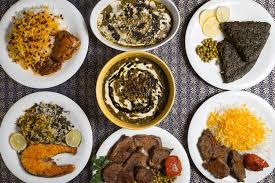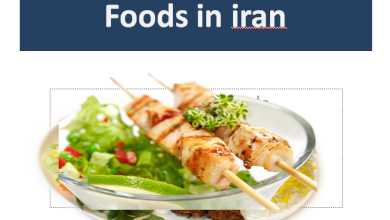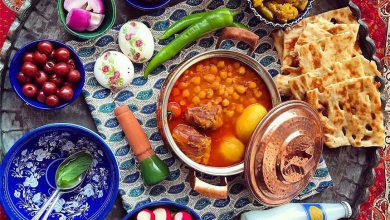
Iranian food is varied and tasty, reflecting the nation’s extensive culinary past. Here are a few well-known Iranian dishes:
Grilled skewers of marinated meats (such as lamb, cattle, or chicken) are known as chelo kebabs, and they are typically served with flavorful saffron rice.
Ghormeh Sabzi: A stew cooked with red kidney beans, tender chunks of meat (commonly lamb or beef), and sautéed herbs (parsley, leeks, and fenugreek). Usually eaten with rice.
Fesenjan (Pomegranate Walnut Stew) is a hearty and thick stew cooked with ground walnuts, pomegranate molasses, and either chicken, lamb, or beef.
A savory rice cake called a tahchin is cooked with yogurt, saffron-infused rice, and is frequently topped with marinated chicken or lamb.
Dolmeh (Stuffed Vine Leaves) is a dish that is frequently served with a side of yogurt and is made by stuffing grape leaves with a combination of rice, ground beef, and spices.
Zereshk Polo (Barberry Rice) is a type of rice that has been combined with barberries and saffron.
A creamy dip made from roasted eggplant and seasoned with whey, dried mint, and garlic is known as kashk-e Bademjan.
Ash Reshteh is a thick, filling soup that is typically topped with kashk (whey) and fried onions. It is created with a variety of beans, lentils, noodles, and herbs.
Rice roasted with dill which tender broad beans is known as baghali polo and is frequently eaten with lamb.
Joojeh Kebab: Grilled chicken kebabs on skewers that are frequently accompanied by rice or bread.
Halim: A hearty, thick porridge made with a combination of wheat, lentils, and meat (usually lamb or chicken), cooked slowly and flavored with spices.

Traditional lamb or beef stew called abgoosht (Dizi), frequently served with breads and chickpeas, potatoes, and tomatoes.
Kookoo Sabzi: a veggie frittata made with eggs, fresh herbs, and seasonings.
Samanu: A delicious paste produced from germination-stage wheat that is frequently offered during Nowruz (the Iranian New Year) and represents growth and fortune.
Mast-o Khiar: A cooling side dish or dip made with yogurt, cucumbers, mint, and garlic.
Iranian food is renowned for its complex flavors, liberal use of spices, and focus on fresh herbs. These dishes are just a sample of the great and varied cuisine available in Iran.
Iran Dishes Advantages:
Iranian cuisine has several benefits, including a variety of flavors, health benefits, cultural value, and opportunities for group dining. The following are a few benefits of Iranian food:
Rich and Variegated Flavors: Iranian food is recognized for its rich, vivacious flavors. A variety of flavors, from sweet and tangy to savory and spicy, can be produced by using aromatic spices, fresh herbs, saffron, dried fruits, and nuts.
Lean meats, fresh vegetables, lentils, whole grains, and other nutritious ingredients are frequently used in Iranian cuisine. A well-rounded and nutritious diet is one that places a focus on balanced nutrition, uses healthy fats (like olive oil), and includes items that are high in protein.
Use of Fresh Herbs and Spices: Fresh herbs like parsley, cilantro, mint, and dill, which add flavor and provide health advantages, are essential in Iranian cooking. These herbs are full of vitamins, minerals, and antioxidants, which help to improve general health.
Incorporating superfoods: Many Iranian meals include superfoods like pomegranate, walnuts, barberries, and saffron, which have anti-inflammatory and antioxidant characteristics as well as possible heart-health advantages.
Iranian cuisine is rooted in the history, culture, and customs of the nation. It has a rich cultural heritage. Each dish frequently has a special backstory that reflects the culture and principles of the Iranian people. Having these meals together promotes cultural identity preservation and celebration.

Typical Community Dining: Iranian meals are frequently shared family-style, fostering a sense of cohesion and community. To eat a variety of foods and strengthen social ties, family and friends assemble around a sofreh (traditional tablecloth).
Iranian cuisine includes a wide variety of vegetarian and vegan meals, making it acceptable for people with different dietary requirements. Meals that are pleasant and healthful are frequently made using legumes, vegetables, grains, and plant-based proteins.
Respect for Seasonal and Local vegetables: Iranian cuisine frequently emphasizes the use of seasonal, locally sourced vegetables to promote sustainability and lower the carbon footprint of food manufacturing and shipping.
Herbal Benefits and Medical Traditions: Some Iranian meals include ingredients with established health advantages, such as those that may improve flow, aid metabolism, or relieve common aches and pains.
Iranian food is an essential component of festivals and celebrations, sustaining cultural traditions and customs at occasions like Nowruz (the Iranian New Year) and other notable occasions.

Iranian cuisine is a special and beloved part of Iran’s cultural tapestry because it delivers a fascinating gastronomic trip that combines flavors, nutrition, cultural heritage, and social relationships.
The only food available in Iran is halal, as per Iranian law. Alcoholic beverages are not provided with halal meals. The butchering of poultry and fowl for cookery is done in an uncommon Islamic manner. as well as pork, dog, mouse, and other animal meat.



